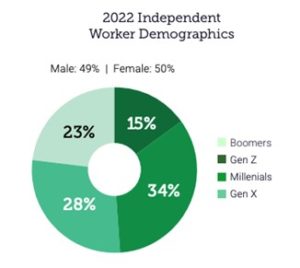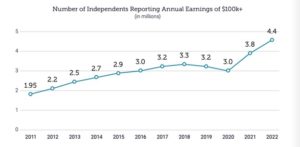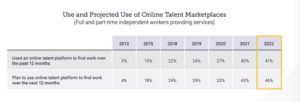 Today, 64.6 million people pursue independent work each year — up a dramatic 69% from 2020. It is important to understand not just who these workers are but what they mean to work as a whole.
Today, 64.6 million people pursue independent work each year — up a dramatic 69% from 2020. It is important to understand not just who these workers are but what they mean to work as a whole.
For 12 years, MBO has explored this segment of the American economy as part of its State of Independence report, an annual deep dive into the size, sentiments and trends impacting the independent workforce.
The data illustrates that independence has far passed a trend, with more than half of all Americans today working or having worked as independents at some point in their careers. Independent work is a viable way for people to earn income, pursue passions and build businesses. And, in a tight labor market, these workers are often among the most in-demand, boasting skills in desired areas such as technology, marketing and project management.
Here are some highlights:
Supply and Demand Growing
Full-time independents jumped 27% to 21.6 million from 15.3 million in 2019. The population of those workers serving enterprises has jumped too, to a total pool of about 8.5 million skilled workers.
Enterprise demand for skilled independent labor is also at an all-time high, with an unemployment rate of just 3.7% and 10.3 million open jobs at the end of October.
 Boomers and Gen Z Alike Bring Value to the Independent Table
Boomers and Gen Z Alike Bring Value to the Independent Table
As the demographics of the American workforce shift, so do the demographics of independents. Gen Z is now making up a full 15% of the independent workforce, and Gen Z and millennials now fully comprise half of the independent workforce overall — notable as these generations widely report higher levels of entrepreneurial desire than past age groups. Boomers make up a significant 26%, with many working to supplement income or because they don’t wish to stop working entirely.
Happier and Healthier
Independents are also more committed to this path than ever before. Today, 76% of independents are “very satisfied,” while 87% feel happier and 80% even call themselves healthier.
PREMIUM CONTENT: Workforce Engagement Decisioning Tool
More People Are Trying Independent Work
Occasional independent work, or the side hustle, is the fastest-growing segment of independence, with more than 31 million doing work this way in 2022. These workers by and large are supplementing income from a traditional job, but it’s also indicative of more workers testing the independent waters and potentially making a full-time leap later. Today, about 17% of Americans hope to go independent in the next two to three years, more than 33 million people.
Independents are earning more, too, with 4.4 million Americans making more than $100,000 annually from independent work, around one in five full time independents today.
Marketplaces Grow in Popularity
How people find work is also changing, with four in ten workers using online marketplaces to find their next project, up from just 3% in 2012 and up sharply from 27% in 2020. Former employers have fallen significantly as a source of work for independents, meaning that in a post-Covid world, workers rely more on their network and other independent sources (including online marketplaces) to source their next projects. For enterprises, this is indicative of a shift in the way workers find projects and indicates reason to consider direct sourcing as a method for finding and engaging top independent talent.
Teaming Is the Way of the Future
Work increasingly is done by teams as well. Independents are more likely than ever before to group with others to deliver larger projects, with 26% saying they have teamed with other independents and 22% of traditional job holders saying they have partnered with independents as well — and this is predicted to continue, with 30% and 29% saying they will do so in the next year, respectively.
These trends illustrate that independent work is far more than the latest workforce trend — it is a vital and growing part of the way we work today, one which corporations must carefully consider as they build not just talent acquisition strategies but overall workforce management strategies as well.










